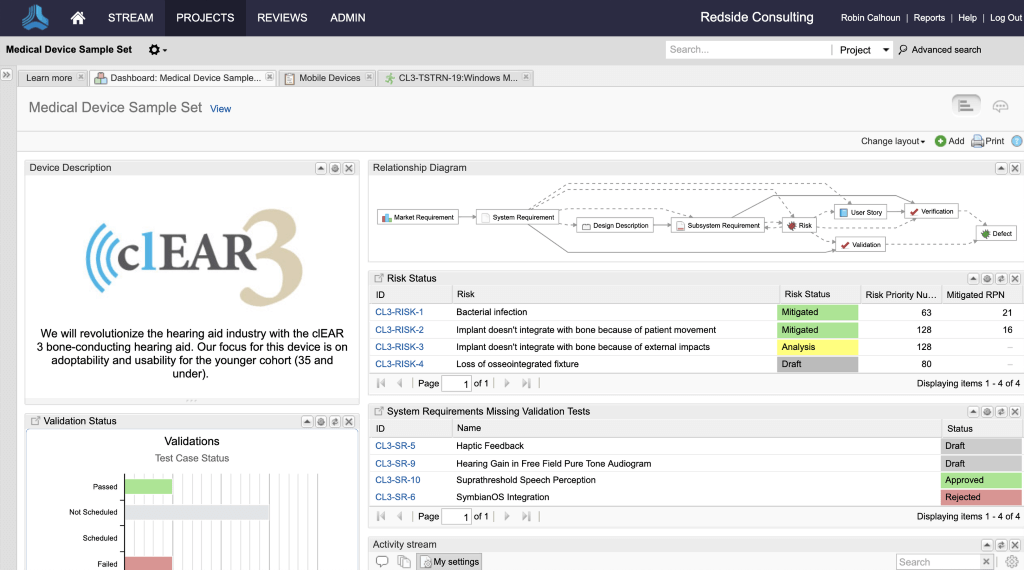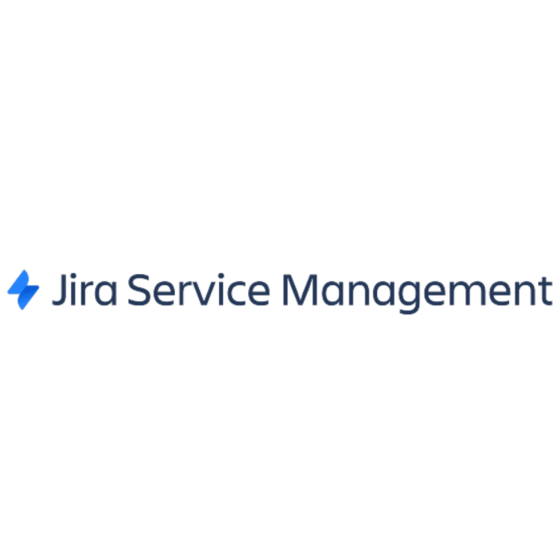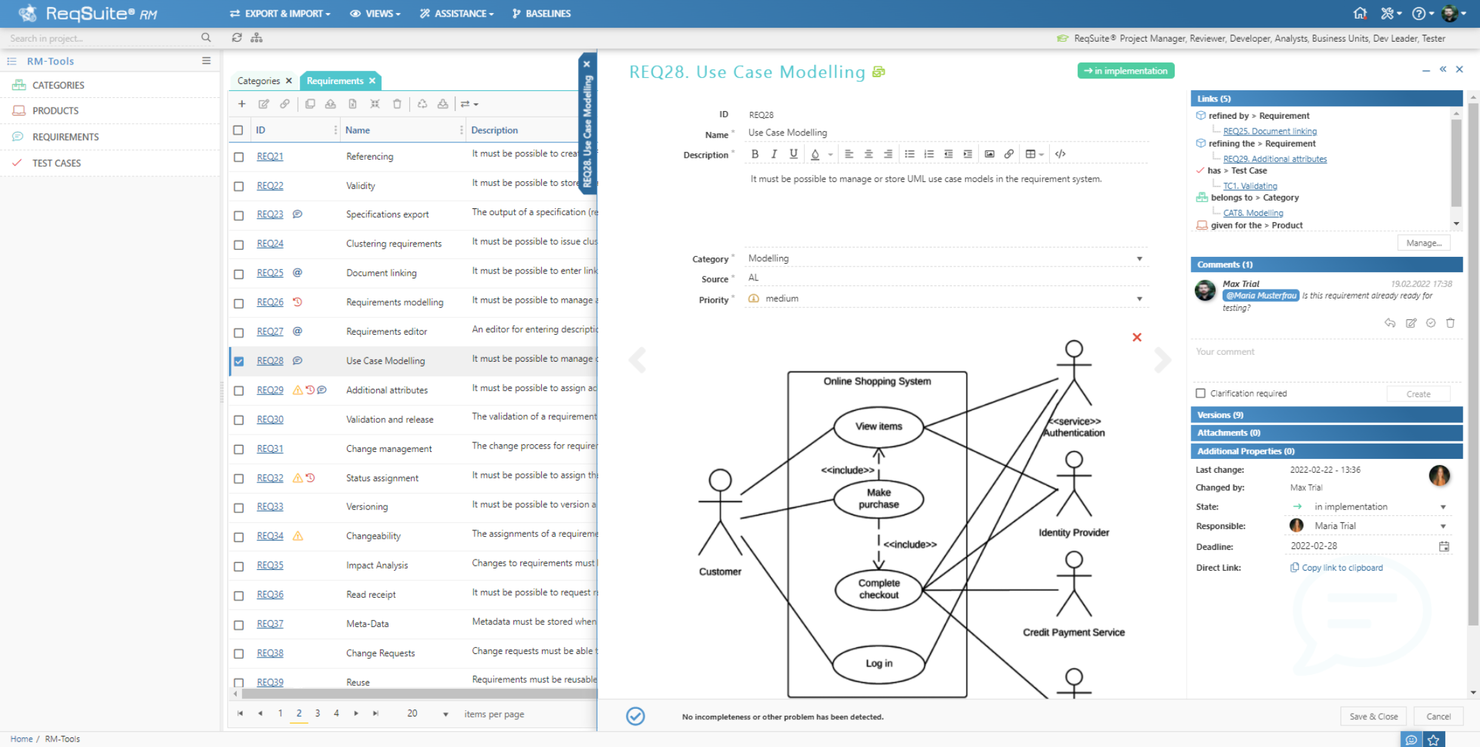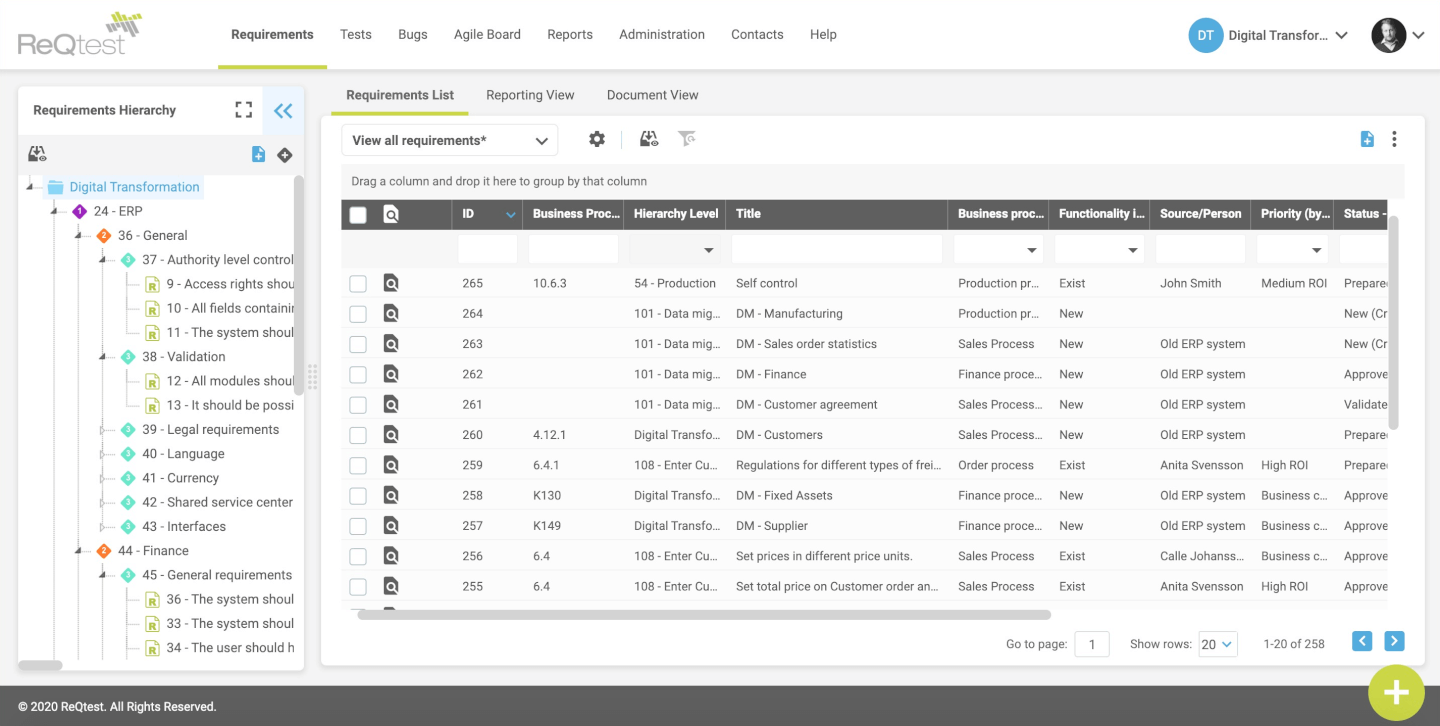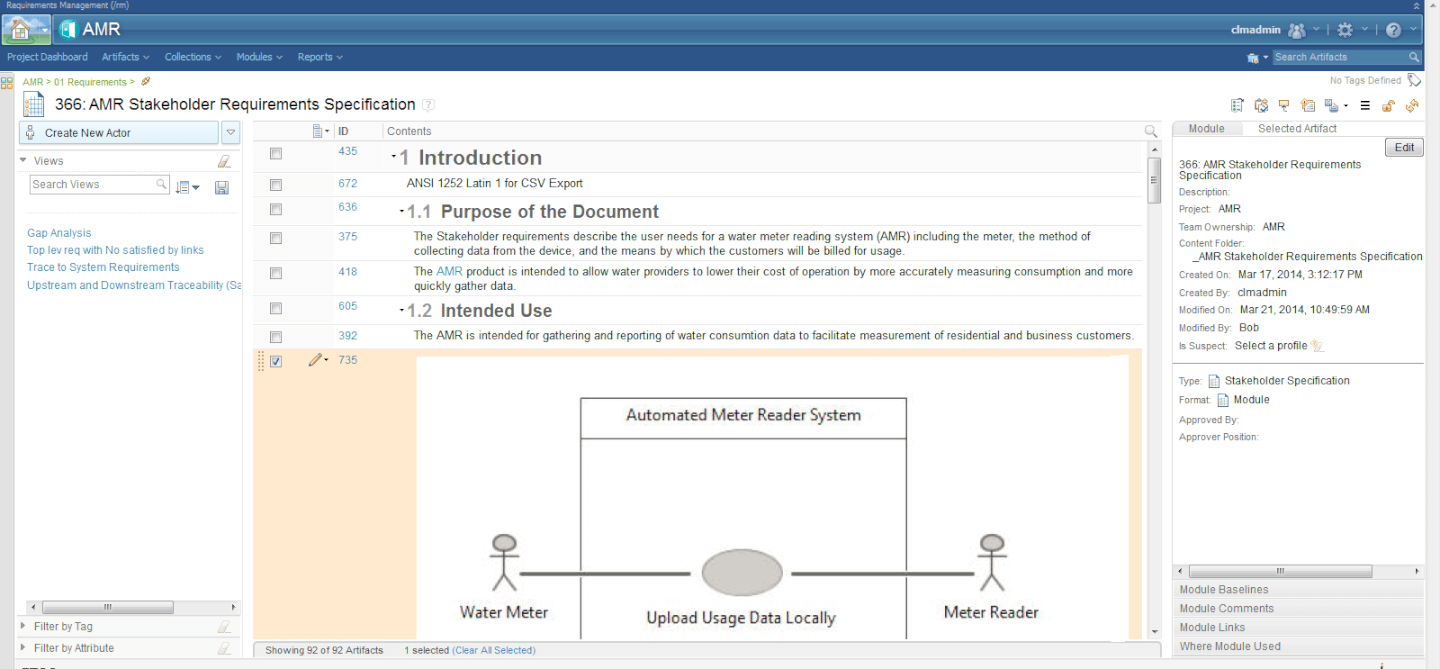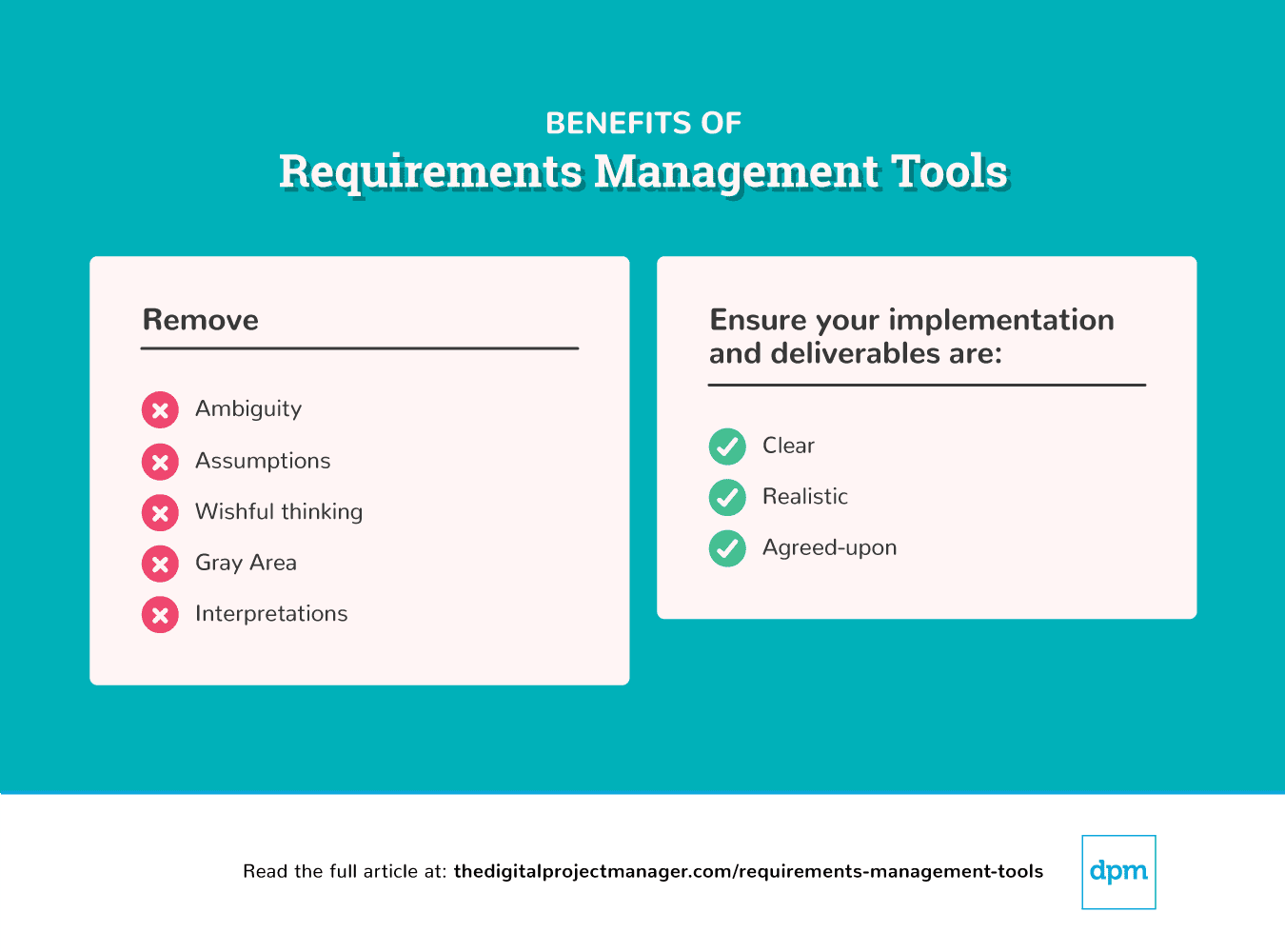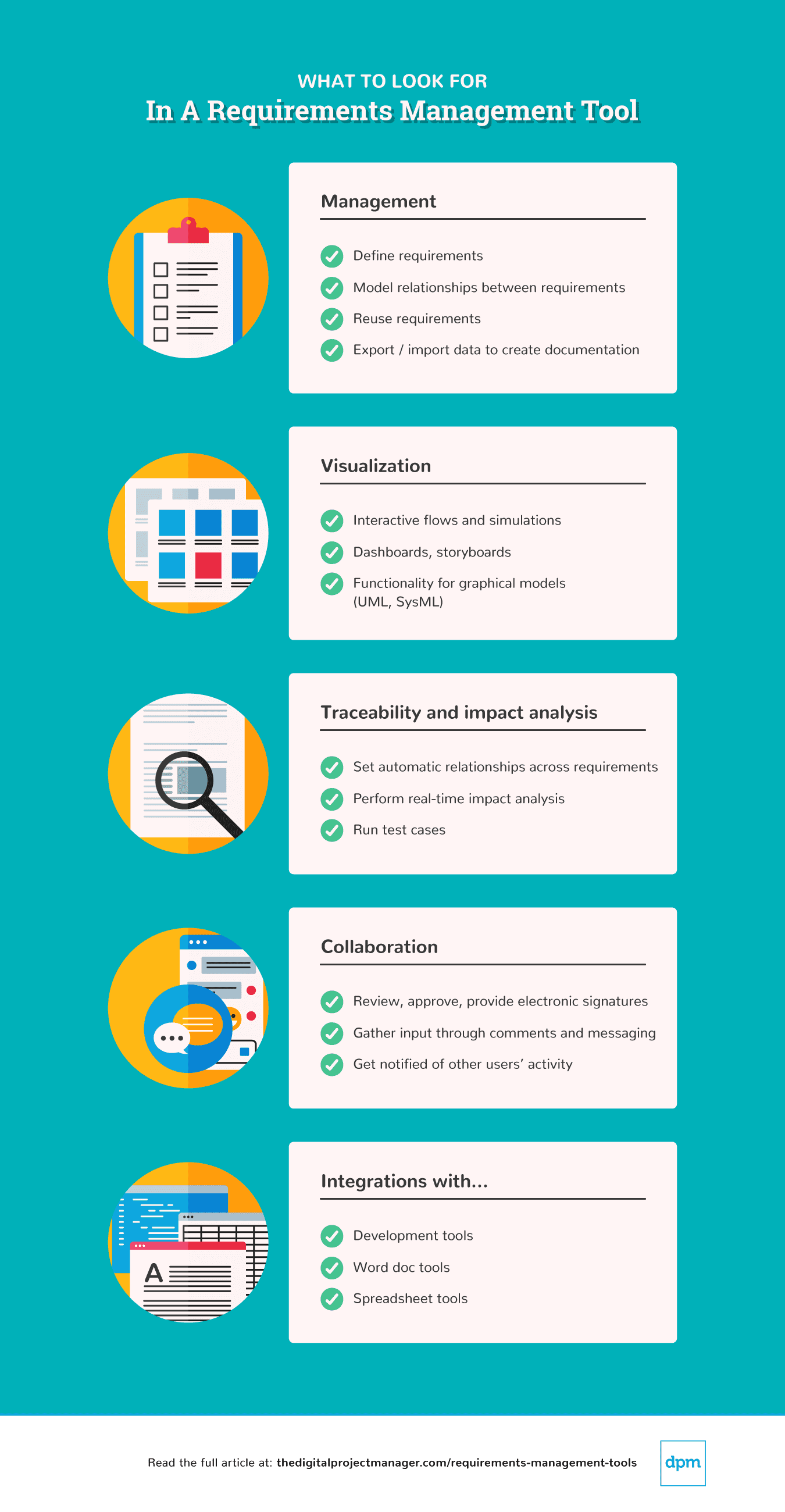10 Best Requirements Management Tools Shortlist
Here's my pick of the 10 best software from the 16 tools reviewed.
Get free help from our project management software advisors to find your match.
With so many different requirements management solutions available, figuring out which is right for you is tough. You need to organize and maintain highly technical specifications about hundreds of requirements but need to figure out which tool is best to collect requirements. I've got you! In this post I'll help make your choice easy, sharing my personal experiences using dozens of different requirements tools with large teams and projects, with my picks of the best requirements management tools.
Why Trust Our Requirements Management Tool Reviews
We’ve been testing and reviewing project management software since 2012. As project managers ourselves, we know how critical and difficult it is to make the right decision when selecting software.
We invest in deep research to help our audience make better software purchasing decisions. We’ve tested more than 2,000 tools for different project management use cases and written over 1,000 comprehensive software reviews. Learn how we stay transparent & our review methodology.
The Best Requirements Management Tools Comparison Chart
The chart below provides a basic summary of the top requirements management tools included in this review. If you want more tools to expand your research, just keep scrolling!
| Tools | Price | |
|---|---|---|
| Jama Software | Pricing Upon Request | Website |
| Jira Service Management | From $21/agent/month | Website |
| ReqSuite® RM | Prices on request (max. €75.00 per user/month) | Website |
| codebeamer | From $125/user/month | Website |
| ReQtest | From $10/user/month | Website |
| xebrio | From $2/user/month with a 10-user minimum | Website |
| Modern Requirements | Pricing upon request | Website |
| IBM Engineering Requirements Management DOORS Next | Pricing Upon Request | Website |
| Orcanos | Pricing upon request | Website |
| Accompa | From $199/month | Website |

Compare Software Specs Side by Side
Use our comparison chart to review and evaluate software specs side-by-side.
Compare SoftwareHow To Choose Requirements Management Tools
With so many different requirements management solutions available, it can be challenging to make decisions on what requirements management software is going to be the best fit for your needs.
As you're shortlisting, trialing, and selecting requirement management tools, consider the following:
- What problem are you trying to solve - Start by identifying the requirements management feature gap you're trying to fill to clarify the features and functionality the requirements management tool needs to provide.
- Who will need to use it - To evaluate cost and requirements, consider who'll be using the software and how many licenses you'll need. You'll need to evaluate if it'll just be the project management professionals, or the whole organization that will require access. When that's clear, it's worth considering if you're prioritizing ease of use for all, or speed for your requirements management tool power users.
- What other tools it needs to work with - Clarify what tools you're replacing, what tools are staying, and the tools you'll need to integrate with, such as accounting, CRM or HR software. You'll need to decide if the tools will need to integrate together, or alternatively, if you can replace multiple tools with one consolidated requirements management tool.
- What outcomes are important - Consider the result that the software needs to deliver to be considered a success. Consider what capability you want to gain, or what you want to improve, and how you will be measuring success. For example, an outcome could be the ability to get greater visibility into performance. You could compare requirements management features until you’re blue in the face but if you aren’t thinking about the outcomes you want to drive, you could be wasting a lot of valuable time.
- How it would work within your organization - Consider the software selection alongside your workflows and delivery methodology. Evaluate what's working well, and the areas that are causing issues that need to be addressed. Remember every business is different — don’t assume that because a tool is popular that it'll work in your organization.
Best Requirements Management Tool Reviews
Here are a few of the best requirements management tools available today. Descriptions include what makes them great, pricing information, and screenshots.
Jama Software provides a platform for requirements, risk, and test management. Teams building complex products, systems, and software use Jama Connect to improve cycle times, increase quality, reduce rework, and minimize effort proving compliance.
This enterprise-grade tool offers the ability to accurately capture and communicate requirements, goals, progress, and interdependencies throughout the development process. It enables you to align hardware, firmware, and software development stakeholders; improve efficiency; manage change; and prove compliance.
In Jama Connect’s features, you’ll find end-to-end live traceability of people, data, and processes, as well as real-time impact analysis, reviews, and approvals with team collaboration. For requirements gathering, you can define, organize, and execute requirements-based test plans and test cases to ensure quality and compliance.
All of these features are packed into a software that provides the flexibility to support various engineering disciplines and development methodologies. Pair that with an intuitive, browser-based interface, and you’ve got a comprehensive software that’s still easy to navigate.
You can integrate Jama Connect requirements and test plans with ALM, PLM, QA, and MBSE to ensure full traceability, visibility, and collaboration across the lifecycle.
With API integrations and third-party integration hubs, teams can work in familiar tools while contributing to projects in Jama Connect. Jama Connect licenses are available on a user and floating basis through an annual subscription model.
Pricing and trial information are available upon request.
Best requirements management tool + ITSM help desk
Jira Service Management is a requirements management software that helps teams manage and resolve customer service requests efficiently and collaboratively.
Jira Service Management is a powerful IT service management software that enables organizations to streamline and automate their service desk operations. Key features include incident management, problem management, change management, and service request management, all of which are fully customizable to fit the unique needs of each organization. Other features include a self-service portal for end-users to submit requests and track their status, SLA tracking and reporting, automation rules for ticket routing and escalation, and integration with other tools and services such as Confluence and Slack. Jira Service Management also offers powerful analytics and reporting capabilities, allowing organizations to track their performance and identify areas for improvement.
Jira Service Management can help with requirements management by allowing users to capture, track, and manage requirements as they evolve throughout the development process. Within Jira Service Management, users can create and track requirements using customized fields, workflows, and issue types that are specific to their organization's needs. Additionally, users can link requirements to other related issues, such as bugs or feature requests, to ensure that all necessary work is completed before the requirement is considered 'done.' Jira Service Management also offers robust reporting and visualization tools that can help stakeholders understand the status and progress of requirements, as well as identify potential roadblocks or areas for improvement.
Jira Service Management integrates with other Atlassian platforms as well as third-party apps like Slack, Mircosoft, Google Workspace, Zoom, AdobeXD, Invision, Figma, Gliffy, Draw.io, Balsamiq, Lucidchart, Miro, Opsgenie, Jenkins, Dynatrace, GitHub, Zendesk, Trello, Optimizely, and hundreds of others via their apps marketplace. You can also build your own using their API.
Jira Service Management costs from $21/agent/month and offers a 7-day free trial.
ReqSuite® RM from OSSENO Software is a very powerful solution for managing requirements, test cases, and other conceptual artifacts along the development cycle.
The software provides a rich toolkit with powerful customization options as well as the ability to collaboratively manage, track, analyze, approve, review, export, import and reuse requirements. Additionally, its ease of use and simple set-up, as well as free premium support means you can get a customized solution quickly running.
The tool also includes AI-based assistance, which helps companies with automatic quality control and requirements matching. ReqSuite® RM also conforms with ISO 26262, IEC 60812, ISO 13485, ISO 14971, FDA 820.30, and DO176C standards.
Integrations include bidirectional sync with several third-party tools, including Jira, Azure DevOps, Enterprise Architect, GitLab, Redmine, TestRail, Word, Excel, and ReqIF - and its WebAPI lets you connect with any other system.
You can get this software as an on-premise or cloud-hosted platform starting at €75.00 per named license.
Intland Software’s codebeamer is a full-stack, end-to-end Application Lifecycle Management platform with strong requirements management capabilities. The tool helps manage complexity from requirements to release in the delivery of safety-critical or traditional software and systems-of-systems products.
For developers of advanced products and software, this open platform extends ALM functionalities with product line configuration, and provides unique configurability for complex processes. Align people, workflows, and tools across the parallel streams of product delivery by enabling teams with a flexible, fully integrated, and highly collaborative platform.
codebeamer is a great tool to support engineers looking for traceability, transparency, and efficient collaboration in requirements management. The platform provides gapless traceability to help track interdependencies and the impact of changes throughout the lifecycle. Requirements-based testing is supported out of the box. Use codebeamer to identify, manage, and track requirements across the lifecycle in order to reduce costs, risks, and delivery times in product development.
Custom reporting options, automated change control, and simple approval management help streamline collaboration in high-velocity development environments. For developers of regulated products, Intland’s preconfigured industry templates and domain services help reduce regulatory compliance effort and costs.
The tool integrates with Jira, Microsoft Word, Excel, IBM Rational DOORS, and plenty more. codebeamer is available as an on-premise or cloud-hosted SaaS platform with flexible licensing options to suit the needs of every team. A free 30-day trial is provided. Pricing information is available upon request.
If you’re looking for a tool that’s easy to implement, access, and learn to use, ReQtest should be at the top of your list. It’s a fully cloud-based tool that you can access from anywhere, with a friendly, transparent pricing model that intentionally accommodates small, agile, and scaling teams (as well as large organizations) with a “pay for what you use” approach.
ReQtest offers a complete suite of useful requirements management tools as well as features designed for agile requirements gathering. These include test management tools, bug tracking, and visual bug reporting tools, end-to-end requirements traceability, easy data export to Excel, collaboration features, and agile task boards.
This is a lightweight but effective solution that works well if you’re happy with a stand-alone tool (ReQtest has two-way sync with Jira, but no other pre-built integrations) and have no need for it to perform the functions of a full QMS or ALM system.
Overall, it’s one of the most affordably-priced solutions out there. It starts at $10/user/month, making it a low-risk introductory solution, especially for organizations that are using a requirements management tool for the first time.
Xebrio is a complete requirements management ecosystem that empowers teams to communicate with one another while gathering, analyzing, and finalizing requirements.
Additionally, it covers the entire project development lifecycle from requirements to releases. Xebrio’s requirement workflow allows all stakeholders to actively participate during the requirement gathering process and has an approval mechanism to ensure collective consensus.
Xebrio facilitates mapping requirements to tasks, milestones, test cases, and bugs. These requirements can then be traced to releases for end-to-end traceability. Some key features of the tool include requirements version tracking and version traceability, and real-time collaboration for requirements gathering.
Xebrio’s other significant features include task management, test coverage, milestone tracking, and bug tracking. It also supports document collaboration, time-tracking, and reporting.
In essence, Xebrio is a requirements management ecosystem with built-in project management features.
Xebrio has special pricing for startups and small teams, starting from as low as $1/user/month with a 10-user minimum. Paid plans for bigger teams start at $10/user/month and offer a 14-day free trial.
Modern Requirements offers a 4DevOps tool as a single-application solution for everything requirements management. The easy to use tools are built directly into Microsoft’s Azure DevOps, and allow you to create, automate, manage, analyze, and report requirements straight from your Azure DevOps project.
Modern Requirements4DevOps eliminates duplicate work, creates requirements reusability, and connects your requirements directly to your assets. You can build living requirements documents, diagrams, mockups, use case models, and other assets that are updated automatically as requirements change.
The tool also includes a built-in approval process (with e-signatures), easy to create baselines, and always up-to-date trace matrices. This solution allow teams to connect requirements to both development tasks and quality assurance testing for full traceability throughout the project lifecycle.
Built directly into Microsoft’s Azure DevOps, Modern Requirements provides a simple to use interface with the options to toggle off any features that might not be used by a given user. Modern Requirements also has a free guided bootcamp to help walk users through each of the offered tools, as well as professional training and support services at the implementation phase.
Modern Requirements is fully embedded with Microsoft’s Azure DevOps and provides your team with the opportunity to turn your new and existing projects into a single source of truth. They also offer full integrations through their Sync Bridge with all of the common tools.
Licenses are available on a User and Floating basis, and can be purchased as a perpetual license or through a subscription model.
Pricing information available upon request. Free 30-day trial available.
Best for engineering requirements management
IBM Engineering Requirements Management DOORS Next is a big hitter in the requirements management software game, with a comprehensive group of resource management software and companion products.
The main differential feature of IBM Engineering Requirements Management DOORS Next is its interoperability with other tools, including lifecycle management, team collaboration, and systems/software engineering (including MagicDraw, which makes it easy to convert spreadsheets into models that human brains can understand).
As part of the IBM ecosystem, it integrates with Jazz-based products and hosted Jazz solutions as well.
All in all, IBM Engineering Requirements Management DOORS Next offers a flexible solution that works well for large-scale enterprises, offering a high degree of granularity and configurability.
That said, IBM Engineering Requirements Management DOORS’ greatest strength is also its biggest drawback—it’s highly customizable, but at the same time, its large database and general complexity can make configuration management a bit cumbersome.
It’s not the easiest tool for everyone in your organization to use, although they do help you solve this potential issue by offering plenty of support: on-demand webinars, responsive support, how to’s, etc.
DOORS Next costs from $164/month as a SaaS.
The Orcanos requirements management tool offers some better visualization and reporting features than others. This includes real-time dashboards that are intuitive to navigate, as well as their DocGen feature for importing/exporting Word files to easily create a software requirements doc, aided by custom templates and embedded reports.
Orcanos delivers all of your essential requirements tools—end-to-end traceability, some basic collaboration features (messaging, alerts), and test management features. Additionally, users have praised Orcanos for their responsive customer support.
Overall, this is an especially good tool if you’re eventually going to require a full QMS (Quality Management System) or ALM (Application Lifecycle Management)—with this tool, it’s simply a matter of upgrading your plan to gain access to ALM or QMS features for risk assessment, quality control, customer complaint management, etc.
The only downside of this tool is its lack of pre-built integrations (it does integrate with Zapier, however). The pricing plan could also be friendlier—they do offer free 30-day trials, but their basic plan requires a minimum of 5 users (at $69/month each), so it’s not the best fit for smaller organizations.
Orcanos costs from $69/user/month.
Accompa stands out among the crowd, not necessarily for its features but for its overall ease of use, ease of implementation, friendly pricing/payment model, and great customer service.
That said, Accompa doesn’t have the most robust feature set out there. They add new features on a continuous basis, but if you need something comprehensive in the here and now, I’d look to big players like Jama or Rational DOORS. In most cases, however, I wouldn’t be scared off by Accompa’s lack of features.
This solution does offer a truly useful collection of essential features (or else they wouldn’t be on this list!), and these include requirements traceability, automatic change and dependency tracking for impact analysis, discussion boards and alerts for collaboration, and requirements prioritization rules. It also offers some customization, such as custom fields, views, and user roles.
Another advantage of this tool: an above-average set of pre-built integrations, including Jira, FogBugz, HP Quality Center, IBM Rational, IBM Rational ClearQuest, Bugzilla, trac, VersionOne, Rally, Agilefant, Seapine Software, SmartBear, and VisualStudio Team Foundation Server.
Accompa costs from $199/month.
Other Requirements Management Tools
Here are more options that didn’t make the cut for the top 10 but definitely worth your while if you are expanding your tool research.
- Perforce Helix RM
Best for traceability and test case management
- ClickUp
Best for keeping your requirements visible to all stakeholders throughout the project
- Zoho Projects
Best for ongoing updates, communication, and collaboration
- Wrike
Best for cross-departmental collaboration
- Doc Sheets
Best intuitive enterprise requirements management software
- Visure Requirements
Best for enterprise requirements management with high-level customization.
Related Project Management Software Reviews
If you still haven't found what you're looking for here, check out these other related tools that we've tested and evaluated:
- Project Management Software
- Resource Management Software
- Time Tracking Software
- Task Management Software
- Project Tracking Software
- Project Scheduling Software
Selection Criteria For Requirements Management Tools
When selecting requirements management tools, it's vital to focus on functionality that aligns with specific use cases central to capturing, documenting, tracking, and managing project requirements. Based on my experience trialing and researching these tools, I've developed a criteria system that both reflects the diverse needs of software buyers and is weighted to reflect each criterion's importance to my overall evaluation.
Core Requirements Management Tool Functionality (25% of total weighting score): To be considered for inclusion on my list of the best requirements management tools, the solution had to support the ability to fulfill common use cases:
- Centralized repository for requirements documentation
- Traceability of requirements throughout the project lifecycle
- Real-time collaboration and communication features
- Change management and version control capabilities
- Reporting and analytics for project oversight
Additional Standout Features(25% of total weighting score): Standout features distinguish a tool by offering innovative solutions to common project challenges. In this evaluation, we seek tools that go beyond basic functionality with unique features, enhancing the overall project management process. We look for:
- Innovative Functionality: Tools that offer unique features, such as AI-driven insights or advanced integration capabilities, providing users with advanced tools to manage complex requirements efficiently.
- Unique User Experience Enhancements: Tools that leverage user experience innovations, like visual modeling capabilities, which aid in better understanding and communication of project requirements.
- Cutting-edge Technology Integration: The use of the latest technologies to offer solutions that improve the requirements management process, such as real-time collaboration tools that facilitate seamless team work.
- Customization and Flexibility: The ability for users to tailor the tool to their specific project needs, ensuring that the tool can adapt to various project types and sizes.
- Advanced Analytics and Reporting: Tools that offer sophisticated analytics and reporting features, enabling teams to gain insights into project progress and make data-driven decisions.
Usability (10% of total weighting score): Usability is critical for ensuring that all team members, regardless of technical expertise, can effectively utilize the tool. This criterion assesses the tool's interface for ease of use, intuitiveness, and the ability to provide a smooth user experience, facilitating quicker adoption and less frustration among users. Key aspects include:
- Intuitive design that balances power and complexity with ease of use
- Clean, user-friendly interfaces that facilitate quick navigation and information retrieval
- Customizability of dashboards and reports to fit user preferences
Onboarding (10% of total weighting score): A smooth onboarding process is key to getting teams up to speed and realizing the tool's value quickly. We evaluate the availability and quality of training resources, the simplicity of the initial setup, and the support systems in place to assist new users, looking for tools that make it easy to transition and start managing requirements efficiently. Effective onboarding is assessed through:
- Availability of comprehensive training materials, such as videos and interactive product tours
- Pre-built templates and guided setup processes to accelerate the adoption phase
- Responsive customer support and community forums for real-time assistance
Customer Support (10% of total weighting score): Exceptional customer support enhances user satisfaction and ensures that any issues are promptly addressed. This criterion looks at the availability, responsiveness, and helpfulness of the support team, as well as the resources available for users to troubleshoot and resolve issues independently. We evaluate:
- The breadth of support channels available, including live chat, email, and phone support
- Responsiveness and effectiveness of the customer support team
- Access to a knowledge base or FAQ for self-service troubleshooting
Value For Money (10% of total weighting score): Assessing value for money ensures that the tool offers a favorable balance of cost to features, supporting the needs of the organization without unnecessary expenditure. We compare pricing models, feature sets, and scalability to determine if the tool is a financially sound investment for its intended use. This involves:
- Comparing pricing structures against the breadth and depth of features offered
- Assessing scalability options to ensure the tool grows with organizational needs
- Evaluating free trial options or money-back guarantees that allow users to test the tool's value
Customer Reviews (10% of total weighting score): Customer reviews provide real-world insights into how well the tool performs and meets user expectations. By evaluating feedback from a wide range of users, we can gauge overall satisfaction, the effectiveness of the tool in solving specific problems, and any common issues that might affect its utility. The focus is on:
- Overall customer satisfaction and feedback on specific features
- How well the tool meets the advertised benefits and solves users' problems
- The frequency and context of any negative reviews to identify common issues
Using this comprehensive approach helps ensure that I only recommend requirements management tools that align with both immediate and long-term project management needs. Furthermore, this methodical selection process can help users adopt a tool that enhances project efficiency, fosters collaboration among team members, and supports the delivery of high-quality outcomes, thereby contributing to the overall success of project initiatives.
Trends in Requirements Management Tools for 2024
In 2024, requirements management tools are rapidly evolving to reflect a broader shift towards more automated, secure, and intelligent project management solutions. Here, I have identified several trends that I believe will shape requirements management tools—and the field of project management in general—both now and in the future.
- Cloud-Based Solutions and Accessibility: The shift towards cloud-based requirements management tools is evident from the increasing number of platforms offering web-based access and cloud storage. This trend highlights the importance of accessibility and collaboration from anywhere, at any time, catering to the needs of remote and distributed teams.
- Security and Compliance Features: With growing concerns around data privacy and security, there's a noticeable increase in features aimed at enhancing security measures and ensuring compliance with international standards. These features address the critical need for protecting sensitive project information and meeting regulatory requirements, providing peace of mind for users and stakeholders.
- Integration with DevOps and Continuous Integration/Continuous Deployment (CI/CD) Pipelines: The emergence of tools that offer seamless integration with DevOps practices and CI/CD pipelines reflects the industry's move towards more agile and continuous development processes. By aligning requirements management with development workflows, these integrations help in ensuring that project goals are consistently met throughout the development cycle, enhancing efficiency and reducing time to market.
- Adoption of Natural Language Processing (NLP): An increasing number of tools are incorporating NLP for automating the extraction and analysis of requirements from unstructured data sources. This functionality streamlines the process of gathering and organizing requirements, significantly reducing manual effort and improving accuracy in capturing stakeholders' needs.
- Data-driven Decision Support Systems: The integration of decision support systems that leverage project data to provide recommendations and insights is becoming more common. This trend underscores the move towards more data-informed project management, allowing teams to make better decisions based on comprehensive analysis of project requirements, risks, and performance metrics.
These trends reflect a broader move towards more intelligent, secure, and efficient project management tools that cater to the evolving needs of modern development teams. Moreover, as requirements management tools continue to advance, they are becoming increasingly crucial in driving project success by enhancing collaboration, streamlining workflows, and providing deeper insights into project dynamics.
What are Requirements Management Tools?
A requirements management tool is a software application designed to assist in the systematic gathering, documentation, and tracking of project requirements throughout the software development or project lifecycle. These tools provide a centralized platform for capturing, organizing, and managing various types of project requirements, such as functional, technical, and business requirements.
These tools allow you to capture and document detailed project specifications, ensuring a clear understanding among team members, stakeholders, and other project participants. The traceability features help you track the origins of requirements, monitor changes, and ensure that each requirement aligns with the project goals.
Features of Requirements Management Tools
Requirements management tools play a crucial role in the success of a project by ensuring that all requirements are clearly defined, understood, and managed throughout the project lifecycle. These tools help teams to avoid misunderstandings and to align on project goals and expectations. Consequently, it is important to understand what key features you need to look for when selecting the right requirements management tool for you. Here are the most important features to look for in such software.
1. Requirements Capture and Documentation: This feature allows for the easy input and documentation of detailed requirements. This is essential for creating a clear and accessible repository of what needs to be achieved, serving as the foundation for all subsequent project activities.
2. Traceability: This feature ensures that every requirement can be traced back to its source and throughout its lifecycle in the development process. This is vital for understanding the origin of requirements and how they impact the project.
3. Collaboration Tools: This feature facilitates communication among stakeholders. They help in ensuring that everyone involved has a platform to provide input, feedback, and updates, which is critical for maintaining alignment and addressing changes efficiently.
4. Change Management: Change management capabilities allow for the controlled modification of requirements. This feature is important for adapting to changes without disrupting the project flow or losing sight of the original goals.
5. Prioritization: The ability to prioritize requirements helps in focusing efforts on what matters most. It aids in resource allocation and ensures that critical requirements are addressed first, optimizing the project's success potential.
6. Version Control: This feature keeps track of changes to requirements documents. It's crucial for maintaining a history of modifications, allowing teams to understand the evolution of requirements and revert to previous versions if necessary.
7. Access Control: Access control mechanisms ensure that sensitive information is only accessible to authorized personnel. This feature protects the integrity and confidentiality of project requirements.
8. Integration Capability: The ability to integrate with other tools, such as project management and software development tools, ensures a seamless flow of information across platforms, enhancing efficiency and reducing the risk of errors.
9. Reporting and Analytics: These features provide insights into the requirements management process. They allow teams to track progress, identify bottlenecks, and make informed decisions based on data.
10. User-Friendly Interface: A user-friendly interface makes it easier for all stakeholders to navigate and use the software. This ensures that the tool is accessible and can be effectively used by everyone involved, regardless of their technical expertise.
Selecting requirements management software with these features ensures that project requirements are handled efficiently from inception to completion. It not only helps in laying down a clear path for project execution, but also in adapting to changes, managing risks, and fostering collaboration among stakeholders. By prioritizing these features, teams can significantly improve their project outcomes and align more closely with their project goals and customer expectations.
Benefits of Requirements Management Tools
Requirements management tools offer a range of benefits that can transform the way teams capture, track, and manage project requirements. Below are five primary benefits of requirements management tools that underscore the value these tools bring to users and organizations:
1. Enhanced Collaboration: By centralizing requirements documentation and providing platforms for real-time feedback and discussion, requirements management tools ensure that all parties are on the same page, reducing misunderstandings and aligning visions across the project.
2. Improved Efficiency: This benefit primarily comes from automating manual processes involved in tracking and updating requirements. These tools save time and reduce errors by streamlining requirement updates, tracking changes, and facilitating quick access to project documentation, thereby accelerating project timelines.
3. Increased Visibility: With this benefit, stakeholders have an overarching view of project requirements, their status, and changes over time. This transparency helps in making informed decisions, prioritizing tasks, and identifying potential bottlenecks early in the development cycle, ultimately leading to more predictable project outcomes.
4. Better Change Management: Change Management capabilities allow teams to adapt to changes more effectively. By managing how requirements evolve over the project lifecycle, these tools help minimize disruptions, ensure that all changes are properly documented, and maintain alignment with project goals.
5. Higher Quality Outcomes: Finally, higher quality outcomes are achieved through precise requirement tracking and validation against project deliverables. This ensures that the final product or service meets the defined needs and expectations, leading to higher customer satisfaction and fewer costly revisions post-deployment.
The benefits of requirements management tools contribute to more efficient project execution, the ability to respond to changes swiftly, and the delivery of higher-quality outcomes. For organizations looking to optimize their project management practices, investing in a robust requirements management tool can be a game-changer, driving success in complex projects and fostering customer satisfaction through meticulous attention to their needs.
Costs & Pricing for Requirements Management Tools
When selecting the right requirements management tool for you, it's important to understand the various plan options and pricing models available. Requirements management tools often come with a range of plans tailored to different sizes of teams and project scopes, from free versions designed for small projects or teams just getting started, to more advanced plans packed with features for larger organizations and complex projects.
Here is a breakdown of typical pricing and plan options you can expect to see during your search:
Plan Comparison Table for Requirements Management Tools
| Plan Type | Average Price | Common Features |
|---|---|---|
| Free | $0 | Basic requirements management, limited users, basic collaboration tools |
| Basic | $10-20/user/month | Enhanced requirements tracking, unlimited projects, basic support |
| Professional | $25-50/user/month | Advanced tracking and reporting, integration capabilities, priority support |
| Enterprise | Custom Pricing | Custom integrations, advanced security, dedicated support, training & onboarding |
When selecting a plan, it is important to consider the size of your team, the complexity of your projects, and the specific features you need to effectively manage your project requirements. The right plan should not only fit your budget, but also provide the tools necessary to streamline your project management processes, improve team collaboration, and meet your specific needs.
Requirements Management Tools Frequently Asked Questions
Find answers to common questions other people have about this topic.
What is RM?
Requirements Management (RM) is the continuous process of gathering, documenting, analyzing, tracking, and agreeing on project requirements. It also entails communicating with stakeholders so we can be aligned on priorities and which requirements should stay or go.
The end goal of RM is to operate with clear, realistic, and agreed-upon requirements.
What are the advantages of using requirements management tools?
Requirements management tools will ensure you agree on an implementation plan and have clear and realistic deliverables. And because it lays out exactly what is included, it also defines what is not. Therefore, it removes ambiguity, leaves no room for assumptions or wishful thinking, and prevents the project from operating in gray areas where misinterpretations happen often.
What key features should I look for in requirements management software?
Learn about some of the features included in this type of software and get familiar with the terminology.
- Requirements management: This includes the ability to define requirements, model relationships between them, reuse requirements, and export/import requirements data for creating requirements documentation.
- Document collaboration: Feature that allows your team to co-create documents and engage in conversations during the creation or review process.
- Baseline management: This includes tracking baselines, having support for different versions of a document, and tracking those changes. Version management will be especially important to guide conversations with the client on what has changed over time. The more we are in control of the changes, the better.
- Traceability and impact analysis: Establishing automatic relationships across requirements is key in requirements management. Traceable requirements and impact analysis include the ability to run test cases. In effect, this allows you to mitigate risks through change management processes when requirements, people, decisions, and timelines inevitably shift during the course of a project.
Why are requirements management tools important?
In our real-world projects, we deal with far too many of those “he said, she said” situations where malformed or vague requirements end up tanking our projects and tarnishing our business relationships. Sometimes the task of requirements documentation falls to a project manager or someone with limited technical proficiency and domain knowledge—they have to cost out a software development project, for example, but they don’t have a ton of experience actually developing software.
And let’s not forget that documenting requirements is simply a tedious task—no one actually wants to spend their time creating (or reading) a 100-page printout of an Excel spreadsheet. Even something as seemingly simple as planning requirements for an online store with no physical inventory can become very complicated.
As project management expert Kelly Suter explained in her complete guide to gathering requirements: “When budgets are thin, timelines are tight, and scope is creeping, requirements documentation tends to be the first deliverable to go and the last deliverable to be considered.”
Thankfully, there are tools that make managing requirements easier. They help you track, test, analyze, visualize requirements, and communicate to stakeholders.
Which requirements mangement software should I use?
The software you use will depend on the project methodology, goals or complexity of the project. Either way, make sure you learn how your team’s terminology for requirements. Some teams use other words, such as user story, product requirement, or feature.
Let’s break down the project complexity.
Basic Requirements Tools
For very basic requirements management planning, you might simply use a spreadsheet or an MS word document template to fill in your requirements documentation.
However, these documents can become problematic. In this case, you rely heavily on individuals to update the documents, and it takes time and effort to ensure you’re working with the most recent version across teams.
Further, managing feedback in a central place becomes a challenge. Often, you have to manage strings of emails and in-person feedback that must be inputted manually into your documentation.
Complex Requirements Tools
In more complex requirement management planning, your tool might be an entire software system for managing the relationships between requirements, analyzing the impact of any changes, managing approvals, and more.
If this is your situation, you will benefit from using one of the tools on this list as they have a range of features to support your requirements-gathering process.
Requirements Management Tools Buyer's Guide
How do you pick the best tool for your team?
All things considered, learning to use and implement a requirements management tool is an investment of time and energy. Before you dive in, you want to ensure that you’re choosing the ideal fit for your projects.
I simplify the process by providing you with some of the most important questions I think you can ask during the selection process in order to narrow down the options.
Identify what you need the tool for
Do you need something that’s one step up from Google Docs and a spreadsheet, or are you looking for an enterprise-grade tool that can support large volumes of data and distributed teams? Do you need additional functionalities such as task management, risk management, or the ability to create mockups? Will you be using the software specifically for software testing?
In general, here’s a basic division of the software on this list to get you started: More lightweight requirements management software includes ReQtest, Accompa, ReqSuite, and Pearls.
More robust requirements management software includes Rational Doors, Perforce Helix RM, Orcanos, and Jama Software. Middle of the road? Look to Modern Requirements4DevOps (built for Azure DevOps) and Caliber.
Decide if you want cloud-based or license-based software
Most requirements documentation software offers the selection between a cloud-based service and an on-premise installation. With this in mind, however, there are several completely cloud-based tools such as Accompa, ReQtest, and Orcanos. Consider your ability to host a solution on-premise. As a result, you’ll be able to narrow down the options significantly.
Consider how easy it is to implement and learn
A couple of factors contribute to how easy a solution is to learn and implement. Consider:
- Cloud-based or on-premise? See above. Right off the bat, a cloud-based Saas will be quicker to implement than an on-premise solution.
- Availability of training and support? If you expect your team to require some training and ongoing support, look to requirements management tools that have received praise for their above-average training and support: SpiraTeam, Rational Doors, ReqSuite, Accompa, Orcanos, and Perforce Helix RM.
- Pre-built integrations? The tools with the largest number of pre-existing integrations (by far!) are Jama, Accompa, and Perforce Helix RM. If you’re looking to cut down on implementation with a tool that plays nicely with your existing development and business tools, those should be at the top of your list.
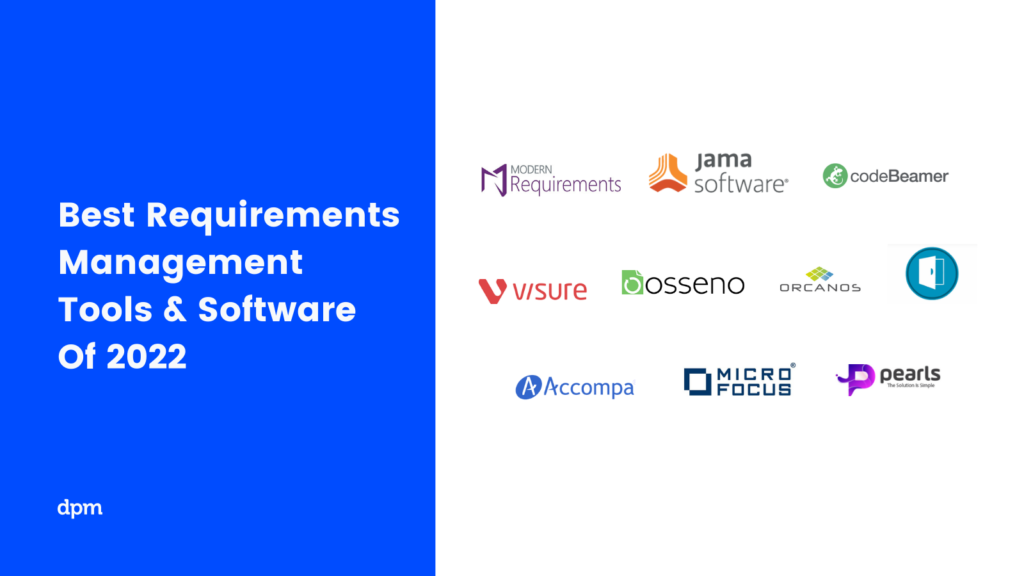
What's Next?
Now that you’ve seen this list, I recommend you read all about how we broke down the requirements-gathering process into 7 easy steps. Also, you might be interested in project scope and how it relates to your requirements.
Subscribe to our Insider Membership newsletter if you want to receive advice on project management, fun stories, reflections, and more in your email every week.





